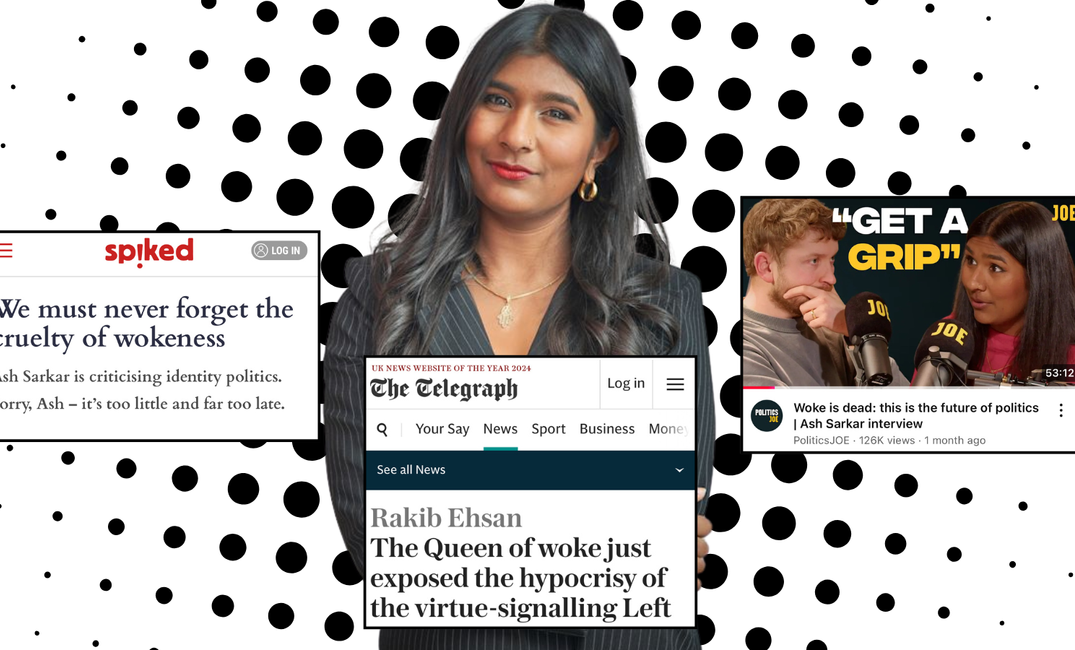“Minority Rule” has stirred the political pot, but what does it have to tell us about the world we're living in?
Banseka Kayembe
If you haven’t already heard, the UK’s most well known communist, and Novara Media journalist Ash Sarkar has written a controversial new book. “Minority Rule: Adventures in the Culture War” has become a bit of a roarshack test, in that wherever you sit on the political spectrum the book means something entirely different. From annoying ultra-rightwing columnists who have appointed her as ‘The Queen of Woke’, to the left rejecting some of Sakar’s diagnosis for why it has failed to build a mass movement, Minority Rule has stirred the political pot.
Her book is arriving at a time when to put it mildly, the left is down bad. The right is not just making a resurgence politically but also culturally. Beyond the bait headlines, circular social media discourse and over the top YouTube thumbnails, what does Minority Rule have to tell us about the world we’re living in?
The i in identity politics
Sarkar starts off strong, with a first chapter dissecting what the left has gotten wrong. Her point is that the “I” in “identity politics” has taken over, making what should be an effort to build coalitions of different groups of people a much more divisive affair. People overly attach a meaning to their identity which only ends up making us more siloed in a polarised world. Sarkar also rightly points out that this pits marginalised interests against each other rather than building shared goals. This all operates within the context of the “attention economy”, where addictive social media platforms push us to compete for likes and engagement. Sarkar adds, perhaps noting her own chronically online position, “perhaps there's some consolation in getting attention, when everything feels…so out of control”.
A bold critique for some, Sarkar highlights “the weaponisation of lived experience” where she argues that people now utilise their identity to justify objectively silly or even harmful points. Ash uses the litmus test of Palestine to expose how this thinking has been taken and adopted by institutions outside the left - such as Chelsea and Westminster hospital removing a display of art work created by Palestinian children after UK Lawyers For Israel said it was making Jewish people feel “victimised and harassed”.
It’s fair to say some of the examples used aren’t always the most rigorous, such as a tweet about how Anne Frank had white privilege with only like ten likes or an anecdote about someone saying “salad spinners are white supremacist”, neither of which necessarily represent the left. There is certainly a danger at times of political journalism focusing too much on what is said online, and not always enough of what’s happening day to day in real life community and activist spaces. The wider landscape of a “woke backlash” probably hasn’t helped.
Moving past the war on woke
But, ultimately so much of what Sarkar pulls together are well-worn critiques that we’ve heard convincingly from many before. Minority Rule is by no means a total rejection of identity politics but a realignment towards the material harms of racism, sexism and transphobia and connecting the dots to join our struggles together and build a united movement to tackle them. Predictably, the mainstream and right wing media have lapped these anecdotes up partly because it’s a much spicier story to frame the book as “Ash Sarkar Queen of Woke Now U-Turns on Wokery!”, but also it’s easier and works in their favour to critique the left rather than their own politics. Ironically, this desire by the media to platform political figures who say things we don’t expect them to - “a woman who decries feminism, a millennial who adores conservatism” -is directly critiqued in the book.
There is something refreshing about someone so vocally political choosing to be vulnerable and honest about what they’ve gotten wrong before, and people’s incredulous reactions to her holding up her hands is testament to how little this actually happens. Self and collective reflection is required for any political movement, and all political ideas are susceptible to being shaped and watered down by more dominant ideas we’re exposed to every day. It can take an enormous amount of critical thinking not to succumb to that - and the idea that leftist ideas have “absorb[ed] so much of Liberalism’s obsession with subjectivity and the individual” is an important warning.
Beyond critiques of the left is where this book really comes into its own. One thing that’s often missing from the conversation about identity politics, is how the right wing utilises it. Often they will be the first to decry “everything being about identity ” only to wind up debating things like eugenics talking points on a YouTube podcast. Sarkar effectively highlights the connections between the moral panic about trans people, the Great Replacement Theory, and the crackdown on abortion rights, doing some good work on how these oppressions are interlinked. Neatly avoiding the class reductionism that is sometimes common on the left, she makes it clear identity is often a key reason for people’s class oppression, not a fringe element that should just be ignored in favour of only talking about class in a narrow way.
The 'white working class' myth
Her assessment of how the use of class has evolved is also refreshing. Building on Owen Jones’ seminal book “Chavs” which explored the demonisation of the working class, Sarkar fills in on where he fell a little short, analysing how race is bound up with class. She explains how the demonisation of working class people partly came from the idea that they fraternised with ethnic minorities, using the 2000s TV character Vicky Pollard from Little Britain as an example. Pollard was symbolic of a feckless, unruly underclass, Ash argues partly because she had multiracial babies from different fathers.
Sarkar then sharply anaylses the reaction to the 2011 riots as a shift away from the “chav” model and a reimagination of the working class as purely white. Media and commentators at the time drummed up a panic about race; historian David Starkey’s view was that the violence was evidence that “the whites had become black”, a racial contamination of the once pure "rosy cheeked white working class”. “The term chavs (…) collapses just as the phrase white working class skyrockets” Sarkar writes, making a convincing case that this sudden interest by media and politicians in the white working class is done to divide working class people.
She concludes that the “Minority Rule” we should be concerned about is of course not marginalised and exploited people, but the real minority rulers: the rich who own pretty much everything. Marxist theory can easily become inaccessible, but Ash chucks out the jargon (swapping rentier capitalists for landlords) and uses storytelling to demonstrate the destructive impact of the capitalist economy. Unlike most political writers she’s adept at balancing the seriousness of the topics with a good load of often self-deprecating humour. The book intends to be more like a detailed diagnosis rather than a practical step by step of how we revolutionise the world, but she makes it clear she wants this to be a blueprint against "passivity and despair”. If you can look past the “end of woke!” clickbait that has surrounded the book’s release, it's a book well worth reading.
Thanks for reading our article! We know young people’s opinions matter and really appreciate everyone who reads us.
Give us a follow on Instagram and TikTok, and join our Whatsapp Channel to stay up to date with what young people think.

